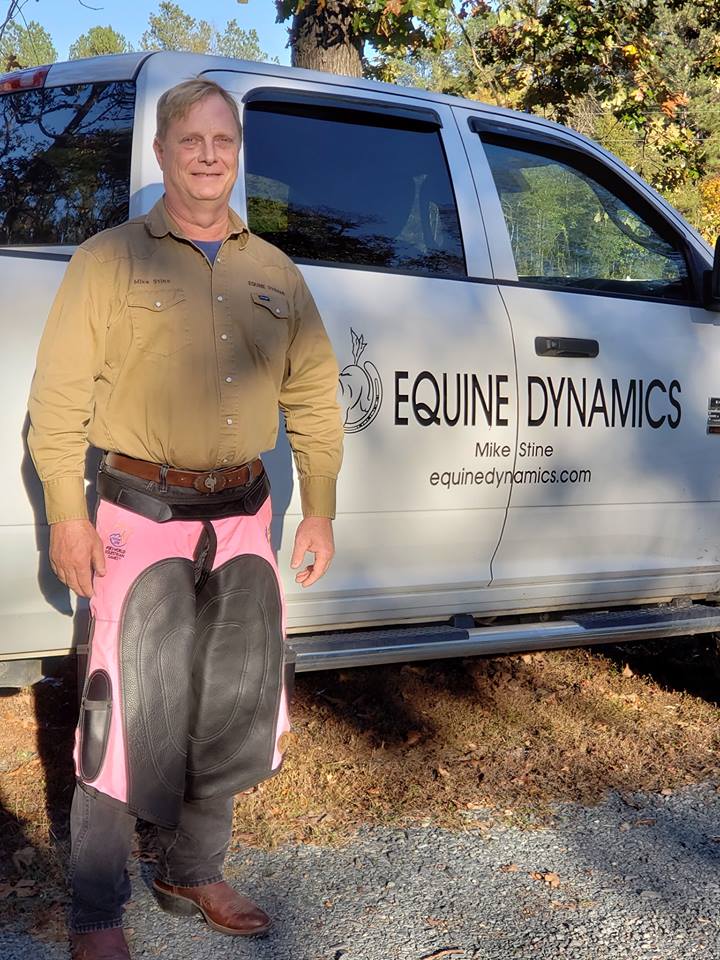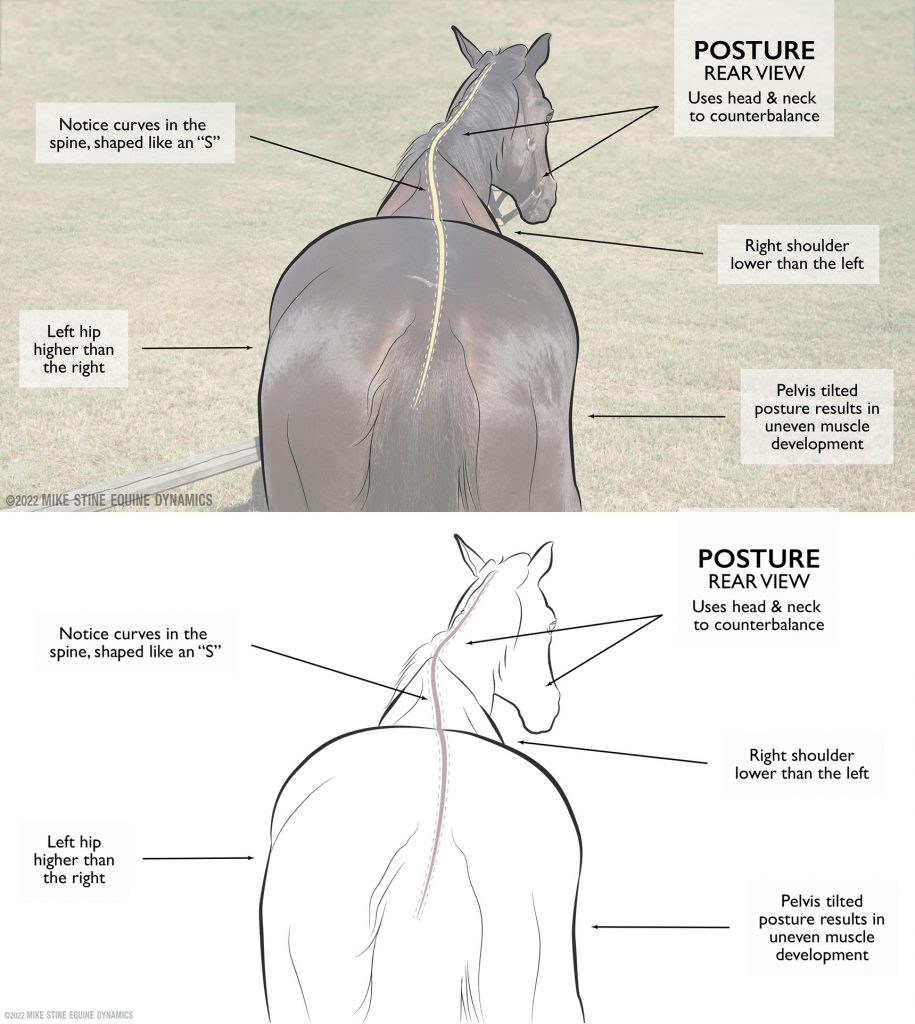
by Kate Richards
Mike Stine’s office geography is the underbelly of a thousand-pound horse.
Whether tending to an eventing, dressage or jumping competitor or a highly tuned racehorse, Stine’s skill set is technically adaptive while his purpose to the equine is an ancient art. Mike Stine is a journeyman farrier and well-known practitioner of what historically were called blacksmiths. In today’s parlance, a farrier that works on a competition sport horse is required to have a bio-mechanical understanding of the entire horse. What begins with the four hooves that carry the speed, the dexterity, and the ability to withstand impact are connected to the rest of the animal’s working parts.
For Mike Stine, working with thoroughbred racehorses is a growing interest, particularly in light of the Horse Integrity and Safety Authority’s edict, dated May 9, regarding the elimination of gripping appliances incorporated in racehorse shoes, except for rim shoes of 2mm or less.
The banning of these applications will be in place as of August 1, 2022, influencing upcoming racing in Saratoga and the West Coast with their occasionally wet weather and sloppy tracks. The rationale for the banning was, in part, the results of studies investigating a potential link between racehorses wearing grabs of a particular height and catastrophic sesamoid fractures.
“This is going to be a hard sell,” said Mike. “I mean, there are 37 or so state-run racing commissions that make up the rules, and with the hoopla in social media, a uniform traction policy was the obvious next step in safety. He paused, “Politics aside, I’m getting ready for the change according to the requirements.”
Towards that end, Stine said “I will welcome the opportunity to visit with racing trainers on this new policy” he offered. He added “And there are different track surfaces, which change depending on the weather/environment of the region in which they are located. No two horses are alike, and every horse adapts to a track surface differently. That requires shoes that will help the horse’s propulsion from the gate to the finish line.” Towards that goal, Stine studies racing videos looking for movement issues that occur when a racehorse is asked to maneuver at high speed.
“There are no two racehorses that are built alike,” said Mike. “You can have identical bloodlines and with that there will be something, the shape of the hind end, the top line, the nostrils, the barrel or even the horse’s ability to accept human direction that differs from one animal to another.
“I was interested in watching the Japanese Derby horse, Crown Pride, train using dressage passes. I shoe a number of second career thoroughbreds retrained for dressage and have talked to show trainers about the transition from the track to the ring. Pondering the rule changes while driving between clients, Stine says “that visual of the passes made me think of ways to manage the lateral movement issue.”
“No one shoe is the better choice” Mike continued. “My farrier rig is loaded with a variety of appliances that can work in variable circumstances. I don’t have a cookie-cutter approach. That’s why staying on top of the science as well as types of the newer shoes available to address a horse’s issues is important to getting the results that the trainer and owners are looking for.”
When asked about his process, he replied “I study the horse and ask questions of their team as to where the horse has been, training intensity, competition level and the surface that they compete on even before I start to work on their feet… I like to start with observing the individual’s gait.”
“Then I build” said Mike. “One hoof at a time, trimming, shaping and finally applying a custom shoe designed for that individual horse. “My goal is how to make the horse work better, more comfortably and more efficiently, while keeping in mind my assignment from the trainer. The more fine-tuned hoof balance is, the better the hoof will absorb concussion upon impact with the surface. This can improve performance and increase the likelihood that the horse remains sound for a career after the racetrack.”
The horse and I, well…when I am in their environment, we are a team. I respect them.” Mike added “I like to think that I speak horse fairly well.”
The qualities of a farrier that works around valuable horses are first and foremost, a deep sensitivity and respect for his charge and for their owners. To meet Mike Stine, one is struck by, firstly, his amiable Southern demeanor and secondly, his reservoir of knowledge about the science of the horse in motion.
A registered journeyman farrier, Mike Stine has conducted clinics in the USA, Australia and New Zealand. He also hosts the podcast “Equine Dynamics with Mike Stine” featured on the iHeart app and YouTube, as well as his website Equine Dynamics.
Mike is also an active member of the International Association of Professional Farriers, with an APF-I credential, and most recently was part of the Official Farrier team providing farrier services for the World Equestrian Games in 2018.
“I think that Mike is a bit of a genius” offered Cynthia Brewster-Keating, who is based in Aiken, South Carolina, and “In my work with shoe and boot compounds, it is a pleasure to come across a farrier that is as educated and offers a versatile approach like Mike Stine. He is very sharp and possesses excellent people skills” she added.
“He is good with the horse’s connections, moreover he can take a complicated problem and drill it down to the understandable” she said. “And that, when you are talking to a nervous trainer or an owner, is gold” Cynthia continued.
Mike explains: “There’s always a better way. That’s why I spend time studying horse hooves and equine movement. I love the art and science of it all.” He smiled. “But most of all, I love it when what I do makes a difference in the horses’ performance.”
Racing connections live in a world of “what ifs.” Responding to a ‘what if a trainer asks if you can add a length or two to racing performance?’ Mike was quiet and then smiled “I can’t make a Secretariat but I can build a better foot.”
Graphics; AE Sabo
Photographs/Images: Mike Stine





